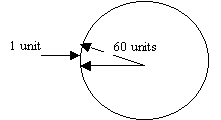| Page Summary | Back to Nav Techniques |
The 1 in 60 Rule
So lets get started with some really easy mathematics…Let a segment of a circle 60 units radius, have a length of
1 unit – see the diagram.

If we assume p
= 3 then 2 x 3 x 60 = the circumference = 360 units.
As a circle has 360 degrees then the 1 unit segment must subtend 1 degree (the circumference divided by 360 degrees).
So What?
If the unit of measure is the Nautical Mile (Nm) then 1 degree off Heading (Hdg) will
result in 1 Nm off track after 60 Nm (the radius) flown.
(This rule will work
with kilometres (Km), statute miles (Stm) or potatoes of uniform size.)
It follows that 2 degrees will result in 2 miles and so on. This approximation will only work up to about 30 degrees because as you move around the circle the accuracy of the approximation degrades, if you are 60 units off track you are actually 90 degrees off Hdg! – think about it (radius 60).
So what happens if the base, or radius is not 60 Nm? Well you have to mentally project the base
distance to 60 and factor the off track error as well. If you are 4 Nm off track at 20 Nm track flown, then you would
be 8 Nm off at 40 Nm flown and 12 at 60. This is set out diagrammatically below:

In the case above at 60 units the track error is ….. That’s right 12 degrees.
It also follows that after 20 units you would be a third of the units off track that you will eventually be at 60 units along off track; if you were 1 unit off in 20 units you would be 3 degrees in error.
And so on….
Although the 1 in 60 rule is just based on approximations they are surprisingly accurate. The calculations are based on Sin and Tan functions, a quick glance at some trigonometry tables will show that the calculations will be accurate up to about 30º but within 10% up to 70º - certainly close enough for government work!
Theory is one thing but how do we use the calculations in practice?
Well the application of 1 in 60 calculus is used for
crosswind estimations, instrument holds, drift calculations and lots of other
times in the air and on the ground. The next paragraphs describe how they are applied to navigation corrections.
Summary
The 1 in 60 Rule gives us a reliable method of providing workable approximations of angles for use in navigation. Given that the accuracy of our own flying and ac instrumentation is such that we can never achieve calculus accuracies, the practical use of the 1 in 60 Rule is adequate for all but the most pedantic of mathematicians. In VFR, the visibility will be such that, provided you look out, you will see the turning point/destination/fix if you fly to within 2 degrees over the normal planning distances between points. Therefore LOOK OUT
By turning complex mathematical track calculations into simple sums, the New Track Reference Technique uses the approximations of the 1 in 60 rule to provide a useful navigation tool for the pilot. Next, we will look more deeply into the application of the 1 in 60 Rule in navigation and The Maximum Drift Technique for planning and flying VFR sorties.